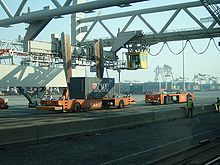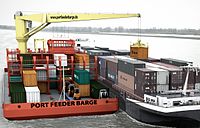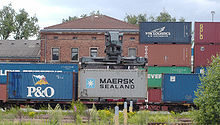Container terminal
A container terminal ( CT ) is a facility at which containers are handled between different means of transport ( intermodal transport ) (for example ship ↔ truck and / or ship ↔ railway wagon).
In addition to ocean-going ship terminals, there are also barge terminals on canals or rivers. There are also container terminals that transfer containers between trucks and railways ( e.g. Eurotunnel = "Chunnel"). In trade in goods containers are often between container ships , feeder ships , barges and land transport ( trucks or railroad ) reloaded ( " folded ") and stored briefly. A lot of attention is paid to refrigerated containers that are electrically connected and whose condition must be regularly monitored and documented. Detached empty container terminals, which were set up to better utilize the capacity of a waterside sea terminal for loaded containers, play a special role.
Container terminals play a special role in the national and international transport chains. They are nodes of the transport routes (see also hub and spoke ) and also manage the mode change (transshipment) between seagoing vessels and feeder ships (feeders) or rail and road. In addition, there are tasks such as the consolidation of loads in containers and the storage and distribution of containers.
development
With the widespread use of standard containers as transport containers since the late 1960s, ships and ports have increasingly been equipped for container handling and transport. The example of the Port of Hamburg shows how rapidly this development has taken place:
On May 9, 1966, the Fairland , a conventional cargo ship converted into a container ship by the US shipping company Sealand, was dispatched in the Neustädter Hafen in Bremen .

In mid-1968, the first US full container ship was handled in Hamburg . In the same year, a terminal for container handling with initially four berths was built in the Waltershof district . In 1969, 60,805 TEU (abbreviation for the equivalent of a 20-foot standard container) were handled, which made up 3.2% of general and bagged goods traffic . In the years that followed, the number of containers handled increased steadily: in 2004, more than seven million TEU were handled here. Well over 90% of the general cargo that is handled in Hamburg and other large European seaports is now in containers.
After 35 years, container handling has dominated conventional handling . It is widely expected that this trend will continue.
In 2009, due to the economic crisis in many industrialized countries , the container terminals in Germany and the USA in particular were hit hard with a drop in handling of up to 25%. The Southeast Asian ports recorded only moderate discounts.
envelope
In the industrialized countries, transshipment mainly takes place with equipment on the shore side, the giant container cranes , which vary in size depending on the port and the width of the ship. Usually they have load capacities of 30 to 40 tons and can handle around 20 to 30 handling operations per hour. In the deep-water ports one speaks of Panamax bridges, since the Panamax container ships have widths of a good 32 meters to around 50 meters. Container cranes are expensive; Therefore, smaller ports in emerging countries often do not have any; then the handling takes place with the ship's own cranes or so-called portal cranes. Universally usable small or medium-sized container ships up to 2500 TEU container spaces usually have their own handling facilities.
Handling data of the largest container ports worldwide
| space | port | 2018 | 2017 | 2016 | 2015 | 2014 | 2013 | 2012 | 2011 | 2010 | 2009 | 2008 | 2007 | 2006 | 2005 | 2004 | 2003 | 2002 |
|---|---|---|---|---|---|---|---|---|---|---|---|---|---|---|---|---|---|---|
| 1. | Shanghai (PR China) | 42,010,000 | 40,230,000 | 37,133,000 | 36,537,000 | 35,285,000 | 33,620,000 | 32,529,000 | 31,739,000 | 29,069,000 | 25,002,000 | 29,918,200 | 27,932,000 | 24,792,400 | 23,192,000 | 21,329,000 | 18,410,500 | 16,940,900 |
| 2. | Singapore (Republic of Singapore) | 36,600,000 | 33,670,000 | 30,904,000 | 30,922,000 | 33,869,300 | 32,600,000 | 29,649,000 | 29,937,700 | 28,430,800 | 25,866,000 | 27,980,000 | 26,168,000 | 21,710,000 | 18,084,000 | 14,557,200 | 11,281,000 | 8,620,000 |
| 3. | Ningbo-Zhoushan (PR China) | 26,350,000 | 24,610,000 | 21,560,000 | 20,620,000 | 19,450,000 | 17,330,000 | 16,830,000 | 14,686,200 | 13,144,000 | 10,502,800 | 11,226,000 | 9,349,000 | 7,068,000 | 5,208,000 | 4,005,500 | 2,772,200 | 1,860,000 |
| 4th | Shenzhen (PR China) | 25,750,000 | 25,210,000 | 23,979,000 | 24,204,000 | 24,037,326 | 23,280,000 | 22,941,000 | 22,569,800 | 22,509,000 | 18,250,000 | 21,413,888 | 21,099,000 | 18,468,900 | 16.197.173 | 13,655,484 | 10,649,900 | 7,613,754 |
| 5. | Guangzhou (PR China) | 21,870,000 | 20,370,000 | 18,858,000 | 17,625,000 | 16,160,000 | 15,310,000 | 14,744,000 | 14,400,000 | 12,550,000 | 11,190,000 | 11.001.300 | 9,200,000 | 6,600,000 | 4,683,000 | 3,308,200 | 2,761,000 | 2,180,000 |
| 6th | Busan (South Korea) | 21,660,000 | 21,400,000 | 19,850,000 | 19,469,000 | 18,651,883 | 17,690,000 | 17,041,000 | 16.175.307 | 14,157,300 | 11,954,850 | 13,425,000 | 13,270,000 | 12,030,000 | 11,840,445 | 11,491,968 | 10,407,809 | 9,453,356 |
| 7th | Hong Kong (PR China) | 19,600,000 | 20,760,000 | 19,813,000 | 20,073,000 | 22,226,000 | 22,350,000 | 23,117,000 | 24,404,000 | 23,532,000 | 20,983,000 | 24,248,000 | 23,881,000 | 23,234,000 | 22,427,000 | 21,984,000 | 20,449,000 | 19,144,000 |
| 8th. | Qingdao (PR China) | 19,320,000 | 18,260,000 | 18,010,000 | 17,510,000 | 16,624,400 | 15,520,000 | 14,500,000 | 13,020,000 | 12,012,000 | 10,260,000 | 10,320,000 | 9,462,000 | 7,702,000 | 6,307,000 | 5,139,700 | 4,238,000 | 3,410,000 |
| 9. | Tianjin (PR China) | 16,010,000 | 15,210,000 | 14,490,000 | 14,090,000 | 14,050,000 | 13,010,000 | 12,300,000 | 11,500,000 | 10,080,000 | 8,700,000 | 8,500,000 | 7,103,000 | 5,900,000 | 4,801,000 | 3,814,000 | 3,015,000 | 2,408,000 |
| 10. | Dubai (UAE) | 14,950,000 | 15,368,000 | 14,772,000 | 15,592,000 | 15,249,000 | 13,640,000 | 13,280,000 | 13,000,000 | 11,600,000 | 11.124.100 | 11,827,299 | 10,653,026 | 8,923,465 | 7,619,222 | 6,428,883 | 5,151,955 | 4,194,264 |
| 11. | Rotterdam (Netherlands) | 14,512,661 | 13,734,334 | 12,385,000 | 12,235,000 | 12,297,570 | 11,620,000 | 11,866,000 | 11,876,920 | 11,145,800 | 9,743,300 | 10,783,825 | 10,790,604 | 9,690,052 | 9,286,757 | 8,280,787 | 7,143,920 | 6,506,311 |
| 12. | Port Klang (Malaysia) | 12,320,000 | 12,060,000 | 13,170,000 | 11,887,000 | 10,945,804 | 10,350,000 | 10,001,000 | 9,604,000 | 8,870,000 | 7,309,780 | 7,970,000 | 7,120,000 | 6,320,000 | 5,543,527 | 5,243,593 | 4,841,235 | 4,533,212 |
| 13. | Antwerp (Belgium) | 11,100,000 | 10,450,000 | 10,037,000 | 9,654,000 | 8,962,000 | 8,590,000 | 8,635,000 | 8,664,243 | 8,468,475 | 7,309,639 | 8,662,890 | 8,175,951 | 7,018,799 | 6,488,029 | 6,063,746 | 5,445,437 | 4,777,151 |
| 14th | Xiamen (PR China) | 10,700,000 | 10,380,000 | 9,614,000 | 9,183,000 | 8,572,400 | 8,010,000 | 7,200,000 | 6,460,700 | 5,820,000 | 4,680,300 | 5,035,000 | ||||||
| 15th | Kaohsiung (Taiwan) | 10,450,000 | 10,240,000 | 10,465,000 | 10,264,000 | 10,560,554 | 9,940,000 | 9,780,000 | 9,636,289 | 8,871,745 | 8,581,300 | 9,676,554 | 10,256,829 | 9,774,670 | 9,470,000 | 9,714,115 | 8,843,365 | 8,493,052 |
| 16. | Dalian (PR China) | 9,770,000 | 9,710,000 | 9,614,000 | 9,450,000 | 10,127,600 | 10,860,000 | 8,060,000 | 6,400,000 | 5,242,000 | 4,576,500 | 4,503,000 | ||||||
| 17th | Los Angeles (USA) | 9,500,000 | 9,340,000 | 8,857,000 | 8,160,000 | 8,340,000 | 7,870,000 | 8,078,000 | 7,940,511 | 7,831,900 | 6,749,000 | 7,849,985 | 8,355,039 | 8,469,853 | 7,484,624 | 7,321,433 | 7,178,940 | 6,105,857 |
| 18th | Tanjung Pelepas (Malaysia) | 8,960,000 | 8,380,000 | 8,281,000 | 9,120,000 | 8,522,936 | 7,630,000 | 7,700,000 | 7,500,000 | 6,530,000 | 6,016,500 | 5,600,000 | 5,500,000 | 4,770,000 | 4,169,177 | 4,020,421 | 3,487,320 | 2,660,000 |
| 19th | Hamburg (Germany) | 8,770,000 | 8,860,000 | 8,910,000 | 8,821,000 | 9,775,745 | 9,300,000 | 8,864,000 | 9,014,165 | 7,895,736 | 7.007.704 | 9,737,110 | 9,889,792 | 8,861,804 | 8,087,545 | 7.003.479 | 6,137,926 | 5,373,999 |
| 20th | Long Beach (USA) | 8,100,000 | 7,540,000 | 6,780,000 | 7,192,000 | 6,821,000 | 6,730,000 | 6,046,000 | 6,061,085 | 6.263.500 | 5,067,600 | 6,487,816 | 7,312,465 | 7,290,365 | 6,709,818 | 5,779,852 | 4,658,124 | 4,526,365 |
| 21st | Laem Chabang (Thailand) | 8,070,000 | 7,760,000 | 7,227,000 | 6,780,000 | 6,583,165 | 6,040,000 | 5,930,000 | 5,731,063 | 5,068,100 | 4,621,600 | 5,134,000 | ||||||
| 22nd |
New York (USA) including New Jersey |
7,180,000 | 6,710,000 | 6,252,000 | 6,372,000 | 5,772,303 | 5,467,000 | 5,530,000 | 5,503,486 | 5,292,000 | 4,561,850 | 5,265,053 | 5,299,105 | 5,128,430 | 4,792,922 | 4,478,480 | 4,067,811 | 3,749,014 |
| 23. | Colombo (Sri Lanka) | 7,050,000 | 6,209,000 | 5,735,000 | 5,185,000 | |||||||||||||
| 24. | Tanjung Priok / Jakarta (Indonesia) | 6,900,000 | 6,080,000 | 5,515,000 | 5,154,000 | 5,034,000 | 6,590,000 | 6,200,000 | 5,618,000 | 4,715,000 | 3,984,000 | |||||||
| 25th | Yingkou (PR China) | 6,490,000 | 6,280,000 | 5,992,000 | 5,768,200 | |||||||||||||
| 26th | Suzhou (PR China) | 6,360,000 | 5,880,000 | 4,450,000 | ||||||||||||||
| 27. | Ho Chi Minh City (Vietnam) | 6,330,000 | 5,930,000 | 5,987,000 | 6,556,000 | 5,148,132 | 5,960,000 | 5,190,000 | 4,674,000 | 4,100,000 | 3,100,000 | |||||||
| 28. | Bremen / Bremerhaven (Germany) | 5,480,000 | 5,514,000 | 5,535,000 | 5,547,000 | 5,795,624 | 5,795,000 | 6,115,000 | 5,915,487 | 4,871,300 | 4,535,850 | 5,529,159 | 4,912,177 | 4,449,624 | 3,743,969 | 3,469,253 | 3,189,853 | 3,031,587 |
See also: List of the largest ports by container handling .

Buffer and storage function
The different lead times and follow-up times on the road or rail, as well as the long journey times by ship, require a different and equalizing distribution of the container quantities over time. The container terminals are therefore also a buffer store with sufficiently large storage areas. These are fenced and guarded.
As a result, it is not necessary for the transport modes involved for land and sea transport to wait for each other. The systematic management of the terminal areas takes into account the expected berths for the ships and the stowage plan in the ship. The aim is to keep the ships' lay times as short as possible. This is done with IT support. If the number of loading tracks is a bottleneck (i.e. because they are scarce), the operator of the terminal areas tries to load and / or unload freight trains in the shortest possible time and to meet deadline requests as far as possible.
automation
In some ports, the containers are transported fully automatically from the crane bridge to the storage area with driverless vehicles that are controlled autonomously (see Container Terminal Altenwerder , Terminal ECT Rotterdam). The choice of the operating concept for a container terminal is determined by the desired flexibility and the available investment budget. Full automation requires significantly higher investments and is less flexible than a terminal managed with manually controlled equipment. In addition, in a fully automatic terminal, for safety reasons, it is not possible to increase the peak performance through mixed operation with a manually controlled device.

The containers in inland terminals are also reloaded from railway wagons to road vehicles using crane bridges or in smaller systems with the help of reach stackers .
See also: Combined Transport
Projects in Germany
In Germany there were and are several large projects to cope with the growing container throughput:
- The container terminal in Bremerhaven was significantly expanded to the north of Terminals I and II (Wilhelm Kaisen Terminal), which had been in existence for a long time: CT III, quay length 800 meters (opened in 1997), CT IIIa with 400 m quay length (commissioned in November 2003) and CT IV with a quay length of 1600 m (construction started in 2004, completion: 1st section at the end of 2006, 2nd section CT IVa 2007). Also deepening and widening of the Weser navigation channel and the turning point to a width of 600 meters. The Bremerhaven container terminal is now around 5.0 km long and, with a floor space of over 2,000,000 m², was the largest contiguous CT in the world; Registered in the Guinness Book of Records since 2004 . After completion of the expansion, the floor space is approx. 3,000,000 m². Since the completion of CT IVa, CT Bremerhaven has been the longest CT in the world on a so-called Stromkaje.
- The JadeWeserPort in Wilhelmshaven is intended not only to supply and remove land transports, but above all to handle sea-going feeder transports for the Baltic Sea and for other ports north of the German Bight. In 2006, Eurogate was awarded the contract to operate the Wilhelmshaven container terminal (CTW). With a water depth of 17.6 m and a quay length of initially 1000 m, later 1725 m, the JadeWeserPort is the only deep-water port in Germany. The official commissioning took place on September 21, 2012.
- Restructuring of HHLA - Container Terminals Burchardkai , the largest in the envelope amount terminals in Germany. Here, parallel to ongoing operations, the capacity was doubled from over two million in 2008 to five million TEU. This was achieved by gradually replacing the previous storage technology (stacking containers with van carriers ) with a storage system with stacking cranes (ASC Automatic Stacking Cranes) with complex, electronically controlled storage optimization. The project started in 2007 and the first stacker cranes have been in use since 2010.

- Renewal of berths 1–3 (already completed) and later westerly expansion at the Eurogate container terminal in Hamburg towards Bubendey-Ufer. The current petroleum port will be filled in for this purpose, and two new mega-ship berths with a total length of more than 1000 m will be created. This will increase the handling capacity of the Eurogate Container Terminal Hamburg by 1.9 million TEU to 6 million TEU. The project also serves to expand the turning circle on the Elbe before entering the harbor basin from 480 m to 600 m in diameter.
- Construction of a new berth and restructuring at the HHLA Tollerort container terminal in Hamburg by 2012. Now around two million TEU can be handled here per year.
- The construction of a new container terminal with a handling capacity of around 3½ million TEU in the central area of the Port of Hamburg ("CTS - Container Terminal Steinwerder") has meanwhile been postponed, now it is not only to be used for container handling.
- The plans for a new container terminal in Hamburg-Moorburg with a handling capacity of up to 6 million TEU ("CTM - Container Terminal Moorburg") have meanwhile been postponed into the distant future.
- Another controversial deepening and fairway adjustment of the Lower and Outer Elbe began at the beginning of 2019 with the preparation of folding points in the Elbe for the dredged material.
Projects in Austria
14 public, bi- and trimodal container terminals are operated in Austria.
- The WienCont Container Terminal, as a subsidiary of Wiener Häfen , has a handling capacity of around 400,000 TEU per year and is the most heavily handled container terminal in Austria and the second largest container terminal in terms of area (after the Krems harbor or METRANS) or one of the largest container terminals with a connection to one Inland port in Europe. Loading is carried out using 3 gantry cranes.
- In 1982 the first gantry crane in Austria was put into operation in the CTS Container Terminal Salzburg . The terminal in Wals-Siezenheim , with a handling capacity of around 300,000 TEU per year, is one of the largest and most important terminals in Austria due to the direct connection to the TEN 17 railway main line and the A1 West Autobahn as well as the close proximity to Salzburg Airport .
Web links
Individual evidence
- ^ Revolution in maritime trade
- ↑ Top 120 Container Ports 2009 (Numerical). (PDF; 4.1 MB) Container Management Magazin, August 11, 2009, archived from the original on February 27, 2012 ; accessed on November 21, 2012 (English).
- ^ Port of Hamburg Marketing eV: Container handling in comparison. Top 20 ports. Port of Hamburg, 2012, accessed on November 21, 2012 .
- ^ Port of Suzhou
- ↑ Axel Godenrath: A lot of noise and no need. Hamburg wants to expand its Eurogate terminal - residents complain. In: Waterkant , issue 1/2017, pp. 21/22; ISSN 1611-1583
- ↑ https://www.bmvit.gv.at/verkehr/habenverkehr/logistik/terminalhandbuch/index.html >






